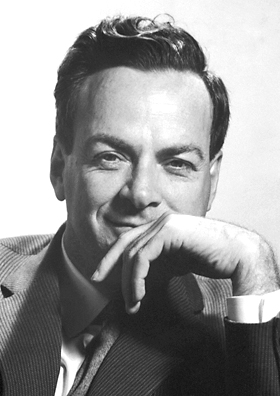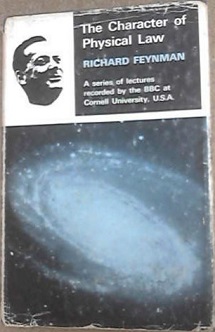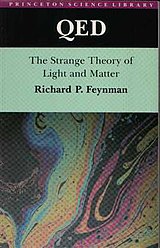
A photon is an elementary particle that is a quantum of the electromagnetic field, including electromagnetic radiation such as light and radio waves, and the force carrier for the electromagnetic force. Photons are massless, so they always move at the speed of light in vacuum, 299792458 m/s. The photon belongs to the class of boson particles.

Quantum mechanics is a fundamental theory in physics that provides a description of the physical properties of nature at the scale of atoms and subatomic particles. It is the foundation of all quantum physics including quantum chemistry, quantum field theory, quantum technology, and quantum information science.

In theoretical physics, quantum field theory (QFT) is a theoretical framework that combines classical field theory, special relativity, and quantum mechanics. QFT is used in particle physics to construct physical models of subatomic particles and in condensed matter physics to construct models of quasiparticles.

In particle physics, quantum electrodynamics (QED) is the relativistic quantum field theory of electrodynamics. In essence, it describes how light and matter interact and is the first theory where full agreement between quantum mechanics and special relativity is achieved. QED mathematically describes all phenomena involving electrically charged particles interacting by means of exchange of photons and represents the quantum counterpart of classical electromagnetism giving a complete account of matter and light interaction.

Richard Phillips Feynman was an American theoretical physicist, known for his work in the path integral formulation of quantum mechanics, the theory of quantum electrodynamics, the physics of the superfluidity of supercooled liquid helium, as well as his work in particle physics for which he proposed the parton model. For his contributions to the development of quantum electrodynamics, Feynman received the Nobel Prize in Physics in 1965 jointly with Julian Schwinger and Shin'ichirō Tomonaga.
A timeline of atomic and subatomic physics.

Julian Seymour Schwinger was a Nobel Prize-winning American theoretical physicist. He is best known for his work on quantum electrodynamics (QED), in particular for developing a relativistically invariant perturbation theory, and for renormalizing QED to one loop order. Schwinger was a physics professor at several universities.

Shinichiro Tomonaga, usually cited as Sin-Itiro Tomonaga in English, was a Japanese physicist, influential in the development of quantum electrodynamics, work for which he was jointly awarded the Nobel Prize in Physics in 1965 along with Richard Feynman and Julian Schwinger.

Renormalization is a collection of techniques in quantum field theory, the statistical mechanics of fields, and the theory of self-similar geometric structures, that are used to treat infinities arising in calculated quantities by altering values of these quantities to compensate for effects of their self-interactions. But even if no infinities arose in loop diagrams in quantum field theory, it could be shown that it would be necessary to renormalize the mass and fields appearing in the original Lagrangian.

In quantum field theory, the quantum vacuum state is the quantum state with the lowest possible energy. Generally, it contains no physical particles. The term zero-point field is sometimes used as a synonym for the vacuum state of a quantized field which is completely individual.

In particle physics, the history of quantum field theory starts with its creation by Paul Dirac, when he attempted to quantize the electromagnetic field in the late 1920s. Heisenberg was awarded the 1932 Nobel Prize in Physics "for the creation of quantum mechanics". Major advances in the theory were made in the 1940s and 1950s, leading to the introduction of renormalized quantum electrodynamics (QED). QED was so successful and accurately predictive that efforts were made to apply the same basic concepts for the other forces of nature. By the late 1970s, these efforts successfully utilized gauge theory in the strong nuclear force and weak nuclear force, producing the modern Standard Model of particle physics.
Quantum mechanics is the study of matter and its interactions with energy on the scale of atomic and subatomic particles. By contrast, classical physics explains matter and energy only on a scale familiar to human experience, including the behavior of astronomical bodies such as the moon. Classical physics is still used in much of modern science and technology. However, towards the end of the 19th century, scientists discovered phenomena in both the large (macro) and the small (micro) worlds that classical physics could not explain. The desire to resolve inconsistencies between observed phenomena and classical theory led to two major revolutions in physics that created a shift in the original scientific paradigm: the theory of relativity and the development of quantum mechanics. This article describes how physicists discovered the limitations of classical physics and developed the main concepts of the quantum theory that replaced it in the early decades of the 20th century. It describes these concepts in roughly the order in which they were first discovered. For a more complete history of the subject, see History of quantum mechanics.
The first Shelter Island Conference on the Foundations of Quantum Mechanics was held from June 2–4, 1947 at the Ram's Head Inn in Shelter Island, New York. Shelter Island was the first major opportunity since Pearl Harbor and the Manhattan Project for the leaders of the American physics community to gather after the war. As Julian Schwinger would later recall, "It was the first time that people who had all this physics pent up in them for five years could talk to each other without somebody peering over their shoulders and saying, 'Is this cleared?'"

The Character of Physical Law is a series of seven lectures by physicist Richard Feynman concerning the nature of the laws of physics. Feynman delivered the lectures in 1964 at Cornell University, as part of the Messenger Lectures series. The BBC recorded the lectures, and published a book under the same title the following year; Cornell published the BBC's recordings online in September 2015. In 2017 MIT Press published, with a new foreword by Frank Wilczek, a paperback reprint of the 1965 book.
The history of quantum mechanics is a fundamental part of the history of modern physics. Quantum mechanics' history, as it interlaces with the history of quantum chemistry, began essentially with a number of different scientific discoveries: the 1838 discovery of cathode rays by Michael Faraday; the 1859–60 winter statement of the black-body radiation problem by Gustav Kirchhoff; the 1877 suggestion by Ludwig Boltzmann that the energy states of a physical system could be discrete; the discovery of the photoelectric effect by Heinrich Hertz in 1887; and the 1900 quantum hypothesis by Max Planck that any energy-radiating atomic system can theoretically be divided into a number of discrete "energy elements" ε such that each of these energy elements is proportional to the frequency ν with which each of them individually radiate energy, as defined by the following formula:
Steven C. Frautschi is an American theoretical physicist, currently professor of physics emeritus at the California Institute of Technology (Caltech). He is known principally for his contributions to the bootstrap theory of the strong interactions and for his contribution to the resolution of the infrared divergence problem in quantum electrodynamics (QED). He was named a Fellow of the American Physical Society in 2015 for "contributions to the introduction of Regge poles into particle physics, elucidation of the role of infrared photons in high energy scattering, and for seminal contributions to undergraduate physics education".

Physics is a scientific discipline that seeks to construct and experimentally test theories of the physical universe. These theories vary in their scope and can be organized into several distinct branches, which are outlined in this article.
Suraj Narayan Gupta is an Indian-born American theoretical physicist, notable for his contributions to quantum field theory. As of 2021, Gupta resides in Franklin, Michigan.

The Feynman Lectures on Physics is a physics textbook based on some lectures by Richard Feynman, a Nobel laureate who has sometimes been called "The Great Explainer". The lectures were presented before undergraduate students at the California Institute of Technology (Caltech), during 1961–1963. The book's co-authors are Feynman, Robert B. Leighton, and Matthew Sands.










